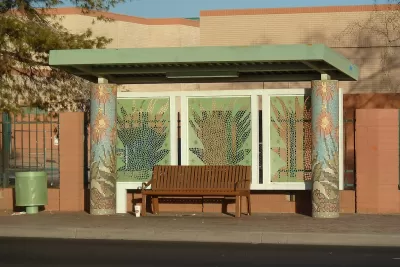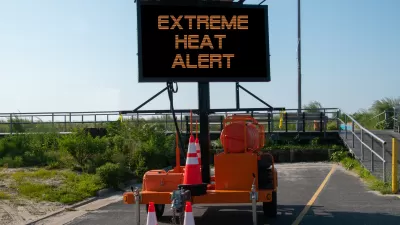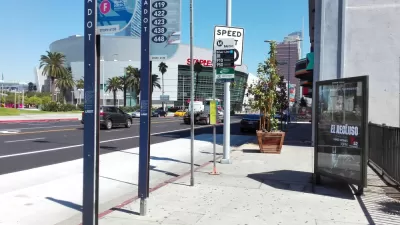The city’s updated Shade Master Plan calls for trees and built structures at bus stops to protect residents from heat.

A “shade plan” developed by the city of Phoenix takes aim at extreme heat with street trees and “engineered shade” to protect residents at bus stops and in other public spaces. As Ysabelle Kempe notes in Smart Cities Dive, “The recently approved plan is an update and expansion of Phoenix’s 2010 Tree and Shade Master Plan.”
The new plan takes a more focused approach to shade, targeting bus stops first. The new approach comes in part as an admission that the city can’t afford to meet its initial blanket goal of shading 30 percent of Phoenix by 2030, but also refocuses efforts on communities that currently lack shade infrastructure. According to Jacob Koch, who helped the city create the plan, “We want to increase the canopy in the places that need it most and that have not had the same level of investment and public infrastructure, historically.”
According to Kempe, “City officials in Phoenix know that more must be done to increase shade beyond the actions outlined in the plan. The document specifically calls out the need to secure more sustained funding sources for this work and to improve the budget and practices for maintaining trees and built shade structures.”
FULL STORY: Not just trees: Phoenix’s $60M shade plan includes built structures, too

Manufactured Crisis: Losing the Nation’s Largest Source of Unsubsidized Affordable Housing
Manufactured housing communities have long been an affordable housing option for millions of people living in the U.S., but that affordability is disappearing rapidly. How did we get here?

Americans May Be Stuck — But Why?
Americans are moving a lot less than they once did, and that is a problem. While Yoni Applebaum, in his highly-publicized article Stuck, gets the reasons badly wrong, it's still important to ask: why are we moving so much less than before?

Using Old Oil and Gas Wells for Green Energy Storage
Penn State researchers have found that repurposing abandoned oil and gas wells for geothermal-assisted compressed-air energy storage can boost efficiency, reduce environmental risks, and support clean energy and job transitions.

Updating LA’s Tree Rules Could Bring More Shade to Underserved Neighborhoods
A new USC study finds that relaxing Los Angeles’ outdated tree planting guidelines could significantly expand urban tree canopy and reduce shade disparities in lower-income neighborhoods, though infrastructure investments are also needed.

California's Canal Solar Projects Aim to Conserve Resources and Expand Clean Energy
California’s Project Nexus has begun generating electricity from solar panels installed over irrigation canals, with researchers and state agencies exploring statewide expansion to conserve water and boost clean energy production.

HHS Staff Cuts Gut Energy Assistance Program
The full staff of a federal program that distributes heating and cooling assistance for low-income families was laid off, jeopardizing the program’s operations.
Urban Design for Planners 1: Software Tools
This six-course series explores essential urban design concepts using open source software and equips planners with the tools they need to participate fully in the urban design process.
Planning for Universal Design
Learn the tools for implementing Universal Design in planning regulations.
Heyer Gruel & Associates PA
City of Moreno Valley
Institute for Housing and Urban Development Studies (IHS)
City of Grandview
Harvard GSD Executive Education
Salt Lake City
NYU Wagner Graduate School of Public Service
City of Cambridge, Maryland





























